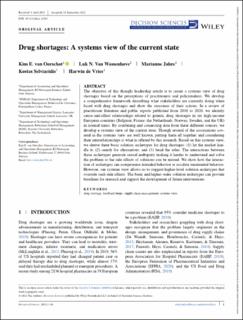| dc.contributor.author | van Oorschot, Kimball Elizabeth | |
| dc.contributor.author | Van Wassenhove, Luk N. | |
| dc.contributor.author | Jahre, Marianne | |
| dc.contributor.author | Selviaridis, Kostas | |
| dc.contributor.author | de Vries, Harwin | |
| dc.date.accessioned | 2023-02-08T13:04:08Z | |
| dc.date.available | 2023-02-08T13:04:08Z | |
| dc.date.created | 2022-11-25T10:05:36Z | |
| dc.date.issued | 2022 | |
| dc.identifier.citation | Decision Sciences. 2022, . | en_US |
| dc.identifier.issn | 0011-7315 | |
| dc.identifier.uri | https://hdl.handle.net/11250/3049310 | |
| dc.description.abstract | The objective of this thought leadership article is to create a systems view of drugshortages based on the perceptions of practitioners and policymakers. We developa comprehensive framework describing what stakeholders are currently doing whenfaced with drug shortages and show the outcomes of their actions. In a review ofpractitioner literature and public reports published from 2010 to 2020, we identifycause-and-effect relationships related to generic drug shortages in six high-incomeEuropean countries (Belgium, France, the Netherlands, Norway, Sweden, and the UK)in normal times. By combining and connecting data from these different sources, wedevelop a systems view of the current state. Though several of the associations cov-ered in the systems view are well known, putting them all together and consideringtheir interrelationships is what is offered by this research. Based on this systems view,we derive three basic solution archetypes for drug shortages: (1) let the market han-dle it; (2) search for alternatives; and (3) bend the rules. The interactions betweenthese archetypes generate causal ambiguity making it harder to understand and solvethe problem as the side effects of solutions can be missed. We show how the interac-tion of archetypes can compromise intended behavior or escalate unintended behavior.However, our systems view allows us to suggest higher-level solution archetypes thatoverrule such side effects. The basic and higher-order solution archetypes can providebaselines for research and support the development of future interventions. | en_US |
| dc.language.iso | eng | en_US |
| dc.publisher | Wiley | en_US |
| dc.rights | Navngivelse 4.0 Internasjonal | * |
| dc.rights.uri | http://creativecommons.org/licenses/by/4.0/deed.no | * |
| dc.subject | drug shortage | en_US |
| dc.subject | feedback loops | en_US |
| dc.subject | supply chain management | en_US |
| dc.subject | systems view | en_US |
| dc.title | Drug shortages: A systems view of the current state | en_US |
| dc.title.alternative | Drug shortages: A systems view of the current state | en_US |
| dc.type | Peer reviewed | en_US |
| dc.type | Journal article | en_US |
| dc.description.version | publishedVersion | en_US |
| dc.source.pagenumber | 0 | en_US |
| dc.source.journal | Decision Sciences | en_US |
| dc.identifier.doi | 10.1111/deci.12583 | |
| dc.identifier.cristin | 2080737 | |
| dc.relation.project | Norges forskningsråd: 300867 | en_US |
| cristin.ispublished | true | |
| cristin.fulltext | original | |
| cristin.qualitycode | 2 | |

